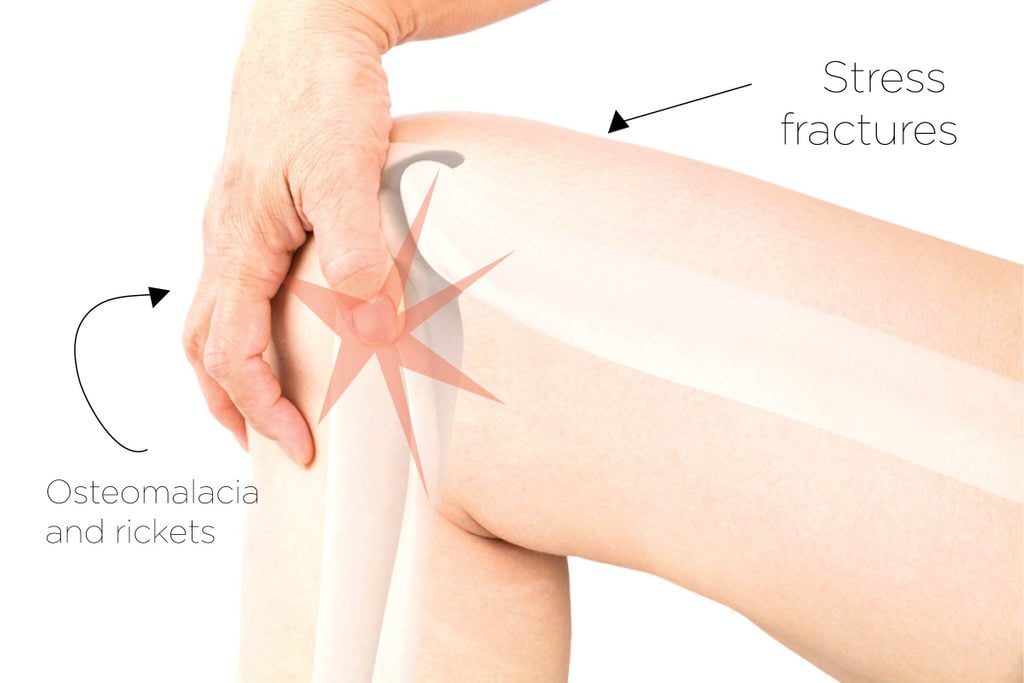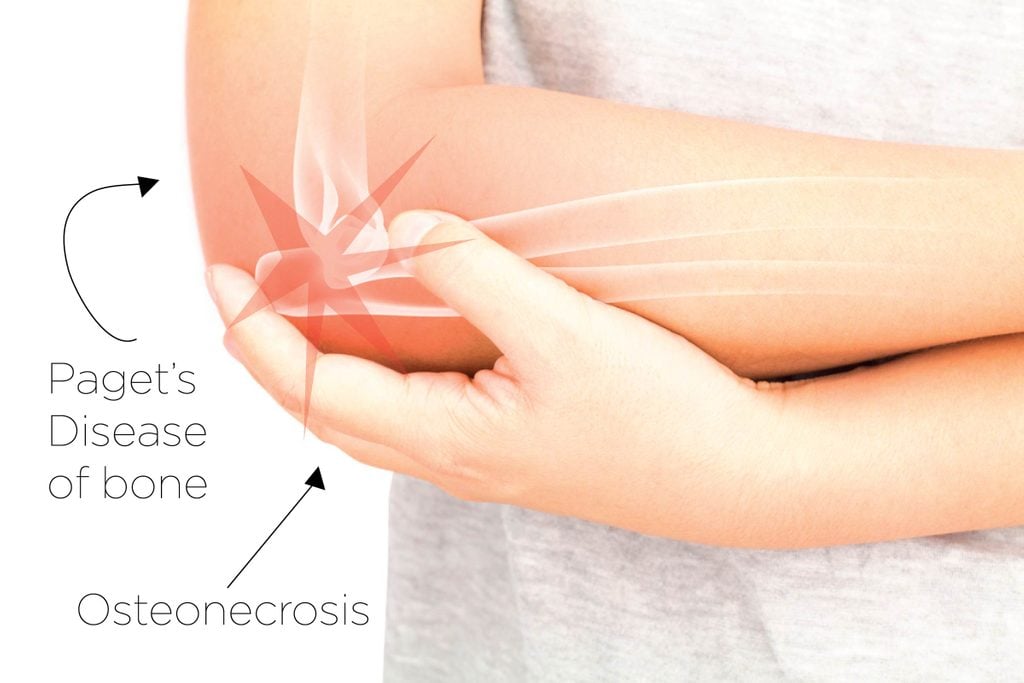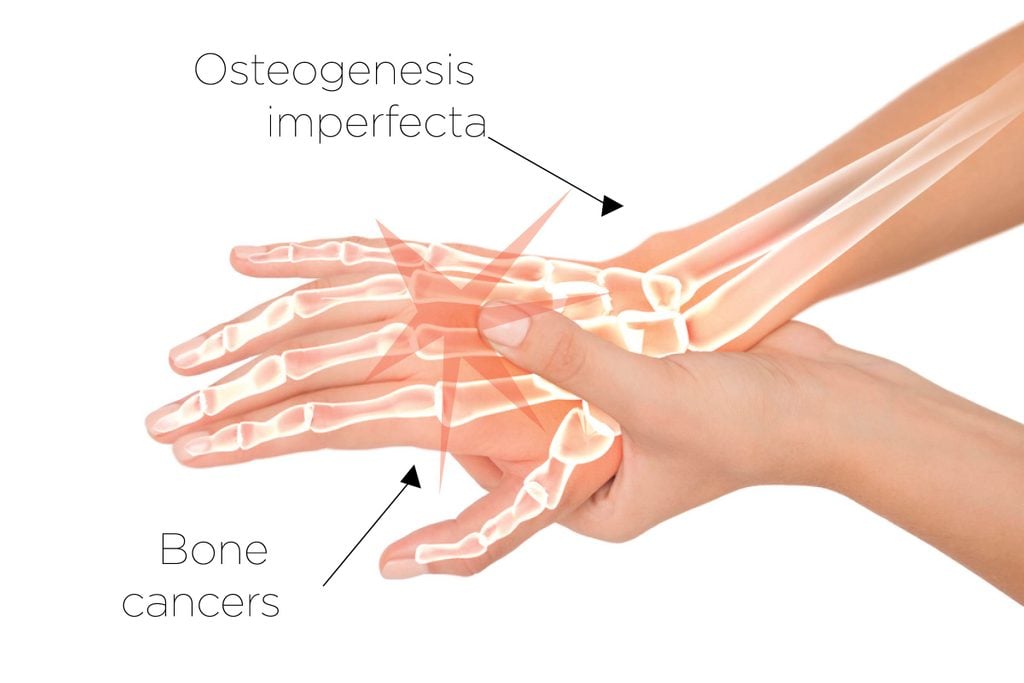6 Bone Health Issues You Don’t Know Enough About—But Should
Updated: Mar. 16, 2017
Unlike osteoporosis, these serious conditions aren’t caused by lifestyle choices—and some can’t even be prevented.
Silent diseases
Osteoporosis, a disease that causes the bones to lose tissue and become brittle. is preventable and treatable, mainly through lifestyle changes. However, some conditions that affect the bones are more difficult to prevent. “These are things that usually other health issues bring on,” says Kurt Kennel, MD, an endocrinologist with a focus in metabolic bone disease at the Mayo Clinic in Rochester, Minnesota. As such, they are typically found incidentally when a person visits the doctor for another reason. Even though they are silent diseases, it’s still important to be aware of these bone issues that could seriously impact your life.

Osteomalacia and rickets
Osteomalacia causes the bones to soften due to a vitamin D deficiency. When the same softening happens in children, it’s called rickets. Osteomalacia can take years to develop, and in the early stages, there may be no symptoms. As it progresses, it can cause an aching pain in the bones, most commonly in the lower back, hips, and legs. Those most at risk for osteomalacia have little exposure to sunlight (a major source of vitamin D), have Celiac disease, or have problems with the liver and kidneys, which help process vitamin D. “The uniqueness (of osteomalacia) is that the problem isn’t in the skeleton; it’s in the gut or kidney. But the skeleton can still get fractures and experience pain,” says Kennel. Getting exposure to sunlight (with proper protection, of course) and eating fortified foods like orange juice and certain cereals can help your body get enough vitamin D. (Don’t miss these 5 easy ways to get more vitamin D in your diet.)
Stress fractures
Young women who do endurance sports and people who are new to the military are most likely to develop stress fractures, but anyone can get them. They’re caused by repetitive force, like repeated jumping or long distance running, and almost always appear in the shins. Sometimes the femur or feet can get fractures. Even though athletes and military personnel are characteristically people in good physical health, sometimes perfectly healthy bones just can’t deal with that level of stress. “The key to prevention is a graduated increase in intensity in exercise,” Kennel says. That means taking breaks after exercise and focusing on lower intensity exercises if you’re starting a new workout. This is when you need to start taking leg pain seriously.

Osteonecrosis
Osteonecrosis, which literally means “dead bone,” is a disease where blood flow is restricted to an area of an otherwise healthy bone and effectively kills the bone. It usually found in the femur near the hip. Risk factors include previous fractures, excessive alcohol consumption, use of steroids, and sickle cell disease. Unfortunately, there’s really no way to prevent it, Kennel says, and people have no idea it’s happening until they experience pain. (These habits will only make your pain worse.) If the damage is severe enough, it may require bone surgery or joint replacement.
Paget’s Disease of bone
Though there are a declining number of incidents, Kennel says this is still considered a classic bone disease generally found in older adults (aged 60-80) of European descent. The chronic condition interferes with a bone’s metabolism so the bone can’t properly heal itself. The result is a fragile, misshapen bone that can lead to other medical problems depending on which bone is affected. If it’s a vertebra, the bone could compress the spinal cord. If the skull is deformed, it could distort your hearing or loosen your teeth. Doctors aren’t sure what causes it (a virus could be involved), and many who have the disease report no symptoms. Kennel explains it’s often discovered incidentally when an X-ray or other examination is being done on another part of the body.

Osteogenesis imperfecta (or brittle bone disease)
This genetic disorder makes the skeleton extremely fragile and affects 25,000-50,000 people in the U.S. Because it makes bones prone to fractures, it can often be mistaken for child abuse. Parents may bring their child to the hospital with little explanation for the child’s bruises and broken bones because they’re unaware of the bone condition, but to hospital personnel, they’re exhibiting suspicious behavior that requires the involvement of child welfare services. What people don’t consider, Kennel says, is how it affects diagnosed adults who survive infancy. They need to deal with osteoporosis, chronic joint pain (frequently in the knees), and breathing problems like asthma, among other issues, for the rest of their lives.
Bone cancers
Primary bone cancers, malignant tumors that form within bone tissue, are rare. These include osteosarcoma, chondrosarcoma, and the Ewing Sarcoma Family of Tumors (ESFTs). However, almost any type of cancer can spread to the bone, even if it originates in other parts of the body. Breast, lung, and prostate cancers have an affinity of spreading to the bone through blood.